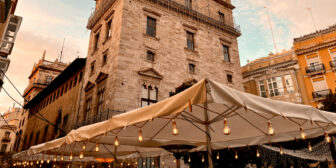Biking in Valencia can be tons of fun. The city’s extensive network of dedicated bike lanes ensures a smooth and enjoyable ride while its picturesque streets and scenic routes are great for exploring on two wheels. But what are the best biking routes in Valencia? Where can you rent a bike? And are there any cycling rules you should be aware of? In this guide, I’ll answer all these questions and more, so you can make the most of your biking experience in Valencia.
In This Article
Why biking in Valencia is so great
Valencia is one of the most bike-friendly cities in Spain. Its smaller and more compact size compared to Madrid and Barcelona make it a biker’s dream come true. Need more convincing? Here are three reasons why Valencia is great for cyclists of all backgrounds and abilities.
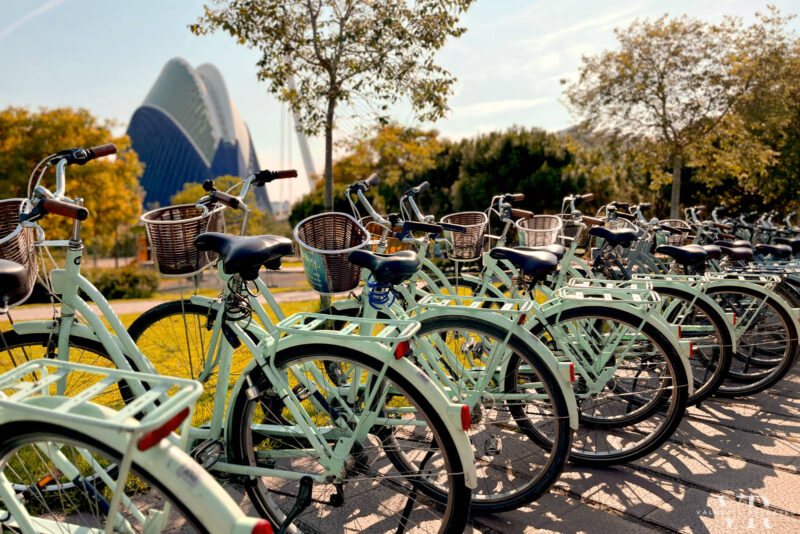
1. Great climate
Valencia has a nearly perfect climate, with over 300 days of sunshine per year, mild winters, and warm summers. This makes biking in Valencia truly enjoyable regardless of the season.
In Valencia, it rarely ever rains and virtually never snows. Freezing cold temperatures are not common either. In the rare cases when the mercury gets close to 0ºC (32°F), it does so during the early hours of the morning, rather than during the day.
However, I won’t sugarcoat it. Summer months, especially July and August, can get quite hot. But the sea breeze helps a lot, and there are heaps of people biking in Valencia even in the heat of summer.
2. Bike lanes everywhere
Biking is an eco-friendly mode of transportation and it aligns perfectly with the local government’s efforts to promote sustainability, reduce air pollution and make Valencia a climate-neutral city by 2030.
As a result, Valencia has a well-developed network of over 160 km of dedicated bike lanes. Additionally, even on streets where bike lanes are absent, bicycles often enjoy preferential access.
But that’s not all. Valencia also has bike lanes that extend far outside the city. This provides plenty of opportunities for exploring the surrounding areas and enjoying day trips from Valencia by bike.
3. Easy navigation
Valencia is as flat as a paella pan and this makes it super easy to move around by bike, regardless of your experience or fitness level.
Cycling adds a lot of flexibility to your Valencia itinerary, as you can stop whenever you want and for as long as you want. This makes it great for exploring Valencia at a slower pace, allowing you to stop at a local café you serendipitously encounter or discover hidden gems that you might otherwise miss.
Last but not least, biking is quicker than walking and in busy areas or during peak traffic hours it can also be faster than taking public transport.
Bike tours in Valencia
Joining a bike tour is one of the best things you can do in Valencia and for good reason. Bike tours can be a pleasant and entertaining way of discovering the city and meeting like-minded people while relying on the expertise of a local guide.
Valencia is home to several companies that provide bike tours. These tours usually follow an optimized itinerary that includes some of the best landmarks and sights in Valencia.
Bike tours in Valencia are usually offered in Spanish, English, Italian, or Dutch, last between 2 and 4 hours, and are suitable for pretty much anyone. However, the route and time of the day the tours take place will slightly differ from one company to the next.
Most guided bike tours will take you through the Old Town before following along the Túria Park in the direction of the City of Arts and Sciences. From there, some of the tours continue to the beach while others return to the starting point.
Renting a bike in Valencia
Valencia has dozens of private bike rental shops as well as a public bike-sharing scheme called Valenbisi.
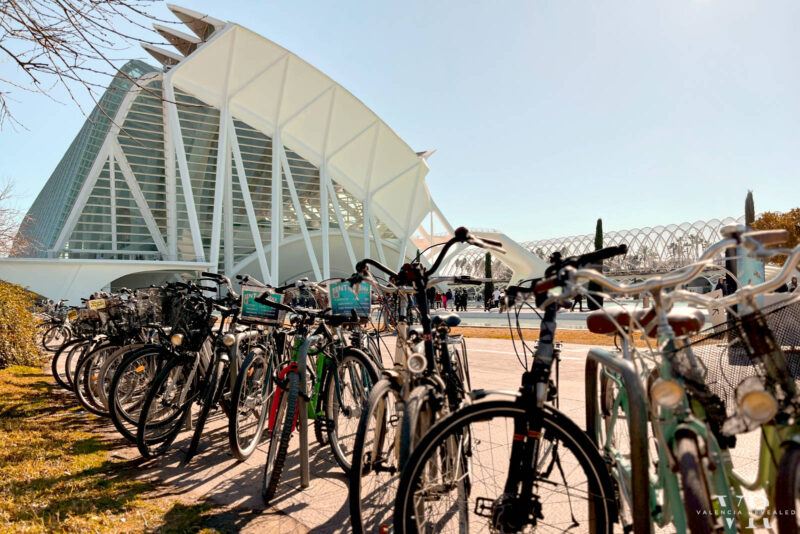
Private bike rental shops
If you’re planning to go biking in Valencia for anything from a few hours to a few days, my advice is to rent a bike from one of the local rental shops.
Many bike rental shops have a variety of bicycle models to suit a wide range of needs and preferences, such as bikes fitted for men or women and smaller bikes for kids. Besides regular bikes, some shops also offer electric bikes and scooters.
The average price per day for a light city bike is around €10, insurance included. If you want to extend your rental period, you can simply call the shop to let them know, without the need to physically stop by. Discounts apply for several-day rentals.
Bike subscription
If you are living in Valencia and biking is your preferred transportation method for moving around the city, you might consider a bike subscription.
Kleta is a bike rental company located in the Ruzafa neighborhood, and they offer 1, 3, and 12-month subscriptions. Their monthly subscription for a regular bike is priced at €34.90, while the annual subscription comes at a discounted rate of €19.90 per month.
Besides regular bicycles, they also have electric bikes at a higher cost. All their plans come with unlimited repairs and an anti-theft guarantee.
Valenbisi
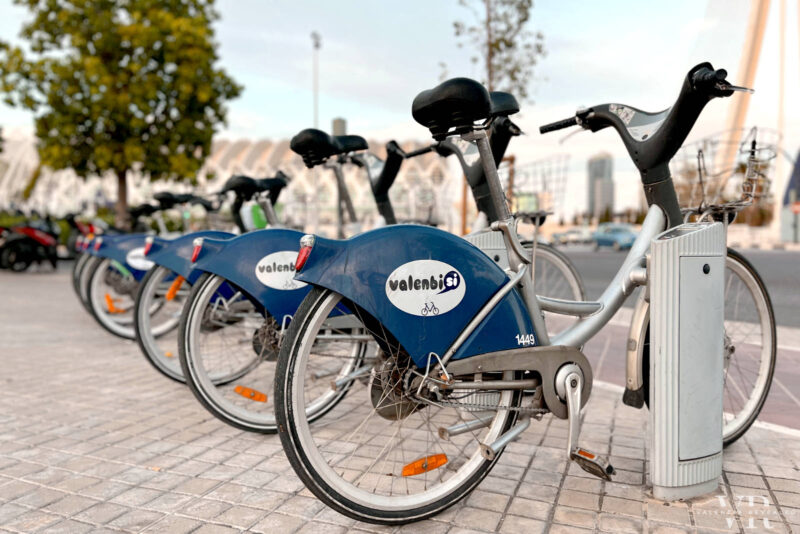
Valenbisi has over 275 bike stations spread throughout the city and their bikes are available 24/7. They offer a super affordable weekly or annual subscription for €13.30 or €29.21 respectively.
One disadvantage of using Valenbici, however, is that their bikes are quite heavy, so they might not be suitable for everyone.
Another disadvantage is that you have to return the bike to the docking station within the first 30 minutes; otherwise, you’ll be charged €0.52 for the first hour and €2.08 for each subsequent hour.
Since they don’t have a physical shop, you have to create an online account with them first. This can be done either through their website or mobile app. You’ll have to give them your bank details and authorize them to make a charge in case you don’t return the bike within the first 30 minutes.
For kids between 14 and 17 years of age, authorization must be signed by a parent or legal guardian.
Best cycling routes in Valencia and its surroundings
There are many cycling routes you can follow in Valencia. Of course, in the city, your chosen route will mostly depend on where you want to go. But if you feel confident in your biking skills, I also recommend you go for a ride outside the city to discover Valencia’s surroundings.
1. Túria Park
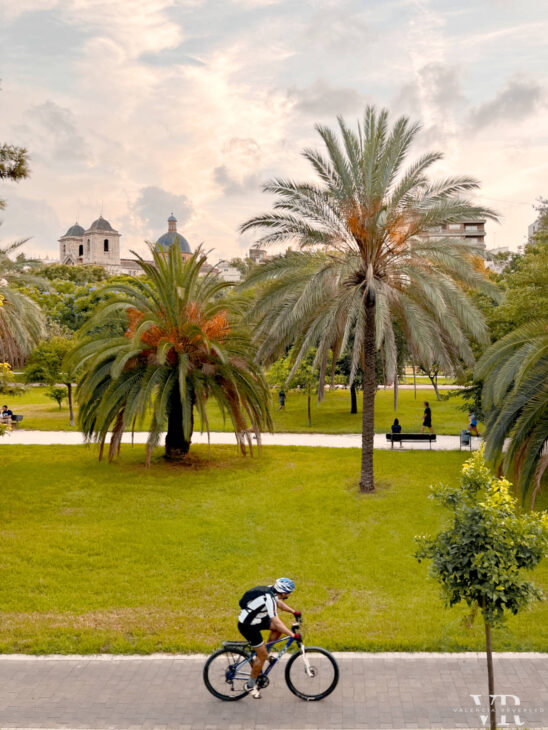
The Túria Park offers the best biking route in Valencia. This urban park stretches for roughly 9 km, from the City of Arts and Sciences to Bioparc, embracing the Old Town.
The park was meticulously planned and created in the former riverbed of the Túria River after it was redirected to the outskirts of the city in the 1960s. It is now one of the largest urban parks in Spain.
What makes this a great biking route is that there are uninterrupted bike lanes from one end of the park to the other. Since you won’t have to cross any roads, biking here is super safe so it’s great for even less experienced bikers and kids.
Also, there are many places you can visit on the way. Several landmarks, museums, and gardens are located along this park. Additionally, you can enjoy a picnic in the shadow of the trees or soak up some sun on the lawn. For more inspiration, check out my post on what to do in Turia Park.
2. Albufera Natural Park

If you want to venture outside the city, the Albufera Natural Park has some of the best cycling routes you can dream of. Situated to the south of Valencia, this nature reserve has a flat terrain and a seamless network of bike lanes that extend from the city. This makes it easily accessible and super popular with bikers.
The Albufera Natural Park is huge. It extends from Pinedo to Cullera over approximately 21,000 hectares. To get here, first pedal in the direction of the City of Arts and Sciences. From there follow CV-500/V-15, cross the bridge and voilà, you’ll have arrived in Albufera.
One of the most popular bike routes in Albufera takes you to El Palmar, the little village where paella was born. The village is not particularly pretty, but it more than makes up for it with fantastic paella and rice restaurants. As you can expect, some of the best paella restaurants in Valencia can be found here.
From the city center of Valencia to El Palmar there are some 22 km each way so the bike ride takes a bit over 1 hour. The bike lane goes along the beach, passing through the El Saler pine forest and continuing along the Albufera Lake.

A big part of Albufera Natural Park is dedicated to the cultivation of rice and has a pretty awesome landscape worth exploring by bike. Also, Albufera sunsets are legendary, both in summer, when the fields are green, and in winter, when the flooded rice fields create the perfect mirror for the end-of-the-day spectacle.
The rice fields are at their greenest from late June to August. However, these are also the hottest months, so the best time of the day for biking is either early morning or late afternoon.
There are no paved bike lanes through the rice fields, but there are plenty of dirt roads with very little traffic that you can follow. Just make sure you wear sunscreen and bring a big thermos with cold water with you as there are no trees to offer you shade and no shops.
One of my favorite cycling routes in Albufera leads to Montañeta de Los Santos, near Sueca. This is a curious little mountain in the middle of the rice fields with unparalleled panoramic views and a hermitage at the top.
The ride here is not the easiest, as you’ll have to pedal some 32 km or approximately 2 hours each way from the center of Valencia. If you want to catch the sunset here, you have the option to take your bike aboard the cercanías train line C-1 to Sueca. Biking between the train station in Sueca and Montañeta de Los Santos only takes 15 minutes.
Also read: 11 Best Places to Watch the Sunset In Valencia
3. The tiger nut fields of Alboraya
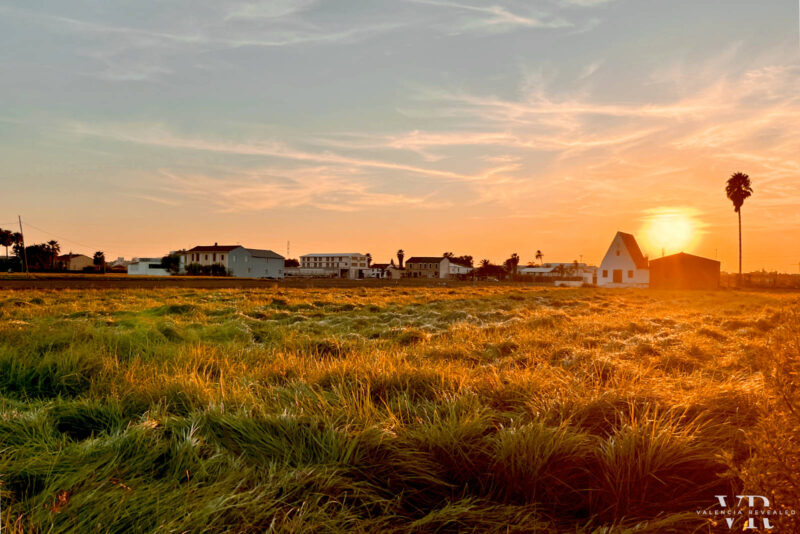
The tiger nut (chufa in Spanish) fields of Alboraya offer another easy cycling route if you want to explore Valencia’s surroundings. These fields are situated just north of the city, have a flat terrain and seamless bike lanes, which makes them super accessible.
Chufa is the main ingredient used to make Valencia’s most popular drink, the horchata (see what is horchata).
Horchata is usually enjoyed during the hot summer months. Similarly, the chufa fields of Alboraya, are at their greenest during June and July, which is when I recommend this biking route the most.
The best time to bike through Alboraya’s chufa fields is at sunset. To get there, first pedal your way to the Benimaclet neighborhood. From there, follow the bike lanes to Alboraya.
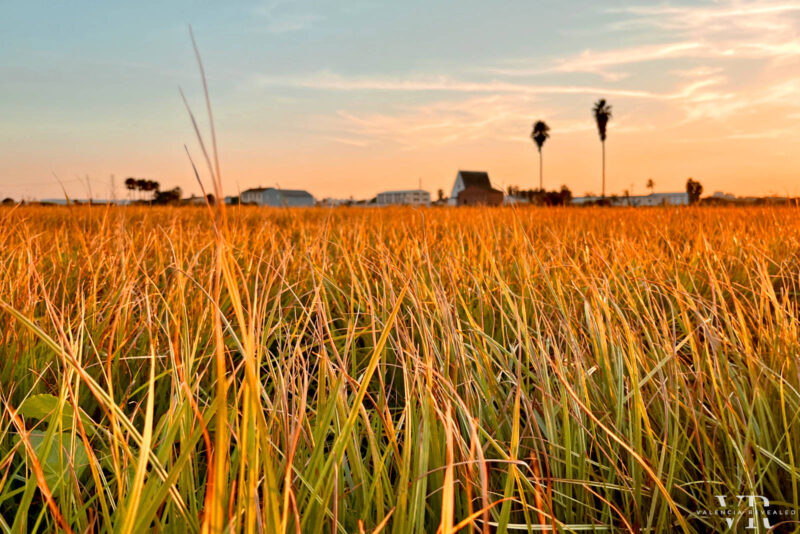
Once in Alboraya, you can stop to enjoy a glass of horchata in one of the many horchaterías in town or follow any of the paved or dirt roads through the chufa fields. While these roads don’t have dedicated bike lanes, they are usually very low-traffic.
If you want to have a glass of ice-cold horchata with a view of the chufa fields, continue to Horchatería Vida – they serve some of the best horchata in Valencia. There’s a bike lane right up to their doorstep and it’s one of the top places I recommend visiting if you’re in Valencia with kids.
Two other cool spots in the middle of the chufa fields are Alquería El Machistre and Espai Sequer Lo Blanch.
Alquería El Machistre is a small museum dedicated to horchata and tiger nuts. They are open from September through June. To visit, you must book in advance.
Espai Sequer Lo Blanch is a nice family restaurant with a large outdoor terrace with views of the fields. They also have very good horchata and their homemade brownies are to die for. On summer weekends, they usually have DJ music playing. You can also get here from Playa de Patacona.
Related: How to Make Spanish Horchata At Home
Cycling rules in Valencia
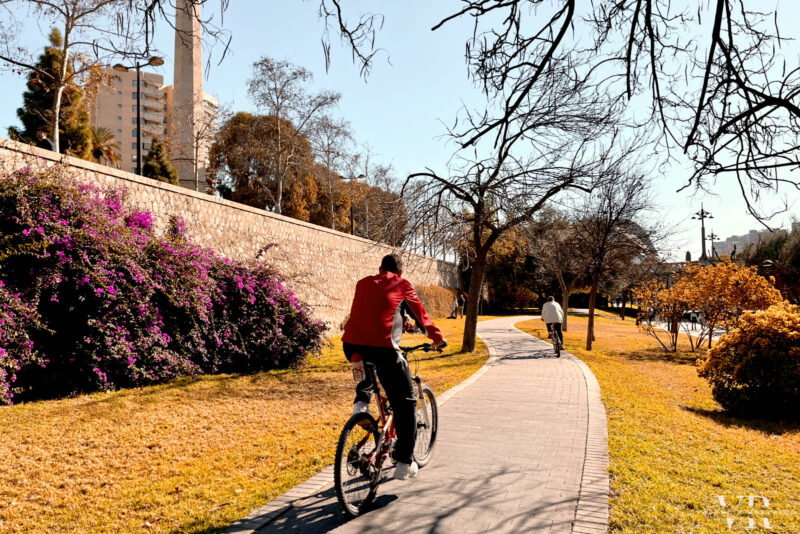
Biking in Valencia is a great way of exploring the city. While the standard traffic rules also apply to bikes, such as stopping at traffic lights, obeying traffic signs, and yielding the right of way when required, here are a few other things you should know when cycling in Valencia!
- Most cycling paths in Valencia are two-way. If cycling in a group, ride single-file and always keep right.
- Riding a bike on sidewalks is prohibited unless there is a marked bike lane painted on the pavement. If you need to be on the sidewalk for any reason, make sure to get off your bike and walk alongside it.
- The maximum speed permitted on cycling paths is 20 km/h. On bike lanes marked on the sidewalks, the maximum speed allowed is 15 km/h. The majority of streets in Valencia have a speed limit of 30 km/h.
- Cycling paths in Valencia are relatively new. Many pedestrians didn’t grow up with them and may unconsciously default to familiar habits. Stay vigilant for pedestrians who might unexpectedly cross your (cycling) path without realizing it, to avoid any potential accidents.
- Cyclists must respect all signs and traffic lights. You must give pedestrians priority at pedestrian crossings.
- The use of mobile phones, earphones, and headphones while riding a bike is totally prohibited.
- When parking your bike on the street, you should preferably use the metal bike racks available. There are thousands of such bike racks all over Valencia. If there is no bike rack nearby, you may also fasten your bike to urban furniture. Tying your bike to trees is not permitted.
- Cycling on bus lanes marked as “EMT” is strictly prohibited as these are reserved solely for buses. However, you can bike on lanes marked as “TAXI-EMT-BICI”, preferably on the red-painted section of these lanes.
- Lane changes must be signaled with the arms.
- Wearing a helmet is highly recommended, although it’s not compulsory in the city, except for children under 16 years of age.
- Where there’s no bike lane parallel to a pedestrian crossing, you must get off your bike and cross on foot.
- When you travel accompanied by a child under the age of 6, it is essential to have an additional seat installed at the back of the bike.
- On Saturdays, Sundays, and holidays, you can take your bike on the metro and tram for free. On weekdays, you can only take your bike on overground sections of the MetroValencia network.
- Folded bikes are allowed on the EMT Valencia buses and the MetroValencia network every day of the week.
- You can also bring your bike on cercanías trains, provided you securely position it in the designated spaces allocated for bicycles.

